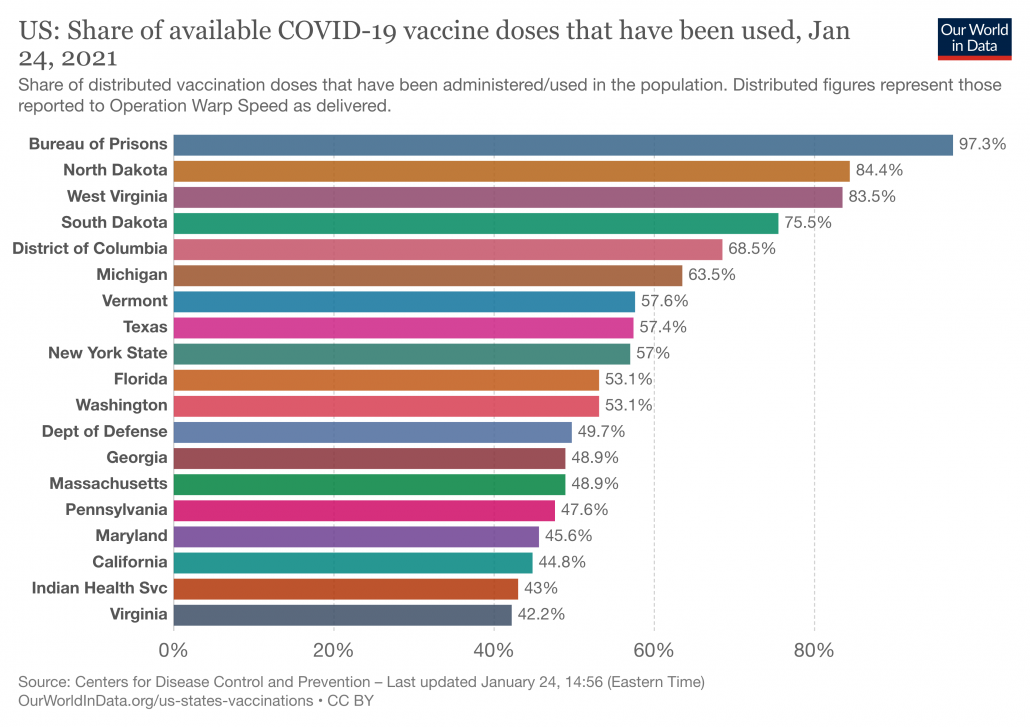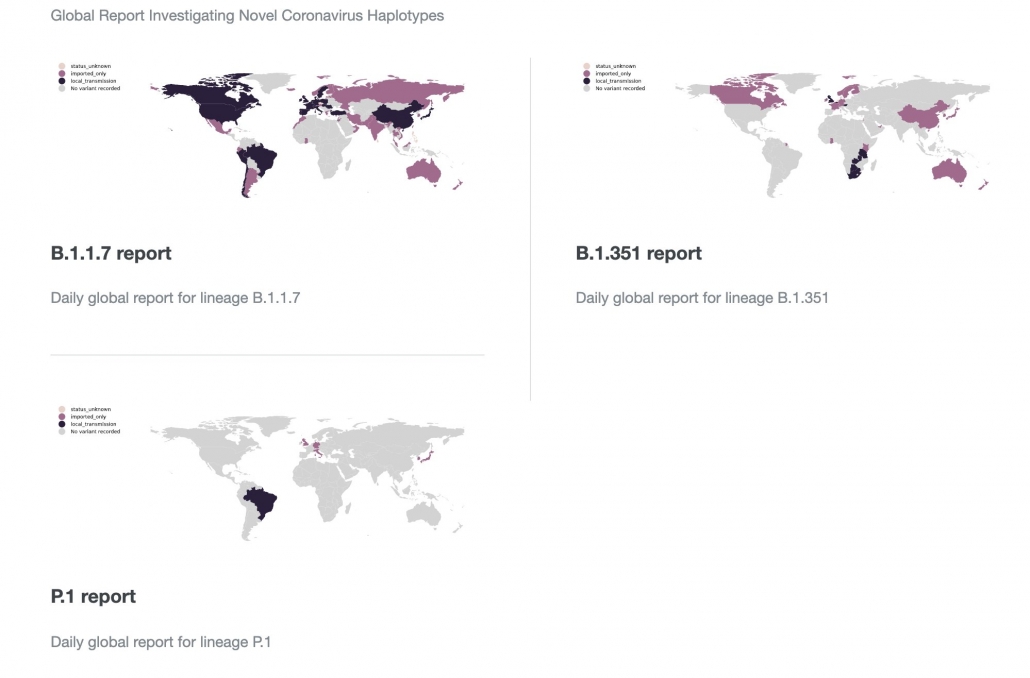Mutants on the Rise
TL;DR: New variants cropping up globally are headed to America and threaten to overwhelm hospitals. Our highly potent vaccines still protect pretty well against new strains, but we are not rolling out vaccine fast enough to prevent new epidemic spikes.
November’s announcement of highly effective COVID-19 vaccines brought a refreshing break in the otherwise bleak pandemic news cycle. New threats are on the rise, however, as a new contagious UK variant has already made landfall in a dozen US states and could soon lead to new epidemic spikes and overcrowded hospitals. The Brazil and South Africa variants could evade some immune defenses and are headed our way as well. Allowing virus populations to explode globally opened the door to evolution. Each of the 100 million confirmed global COVID-19 cases provides another opportunity for the virus to grow and morph into deadlier, more transmissible forms. Bullets are deadly, but at least they do not use each victim as a personal petri dish.
Fortunately, all is not lost. The COVID-19 vaccines were so good to begin with, inducing such a broad antibody response, they can still protect against a variant capable of evading a certain subset of antibodies. So please tell your grandmother to keep hammering her local vaccination registration page, no matter how many times it loses her data. With mass vaccination still the only option for achieving herd immunity, perhaps by mid-2021, the last thing we need is another news cycle fanning America’s enormous problem with vaccine hesitancy.
As you roll up your sleeve for the syringe, be aware that the COVID-19 vaccine is designed to elicit a large, broad immune response potent enough to protect old people with weak immune systems. In the interest of speeding through clinical trials and vaccine distribution, different formulations were not tested for seniors versus young adults, as they are for influenza jabs. As a result, some young adults may have unusually strong immune responses to the vaccine, particularly to their second dose or if they were naturally infected with COVID-19 previously. Most people will have no reactions to the vaccine, but for those who get a fever or a goose egg-sized swelling on their arm, I’m afraid it is simply the price of admission for protection against the deadliest pandemic in over a century. As more variants emerge that evade certain antibodies, we will be grateful that these potent vaccines activate multiple lines of defense.

Note that more people reported muscle pain who received the placebo (vertical black line) than the Moderna vaccine. People get surprised by new medical problems all the time. As millions (billions!) more people get the COVID-19 vaccines, expect an untick in the number of odd strokes, seizures, and deaths that occur right after vaccination by chance. Merely a coincidence of timing in a giant numbers game. Responsible media will not report such events before scientists have time to figure out if they are related to the vaccine or not. Clickbait media will.
Minor vaccine reactions can be a good sign. I exclaimed Perfect! in response to my son’s three days of snotty nose and malaise after receiving a FluMist vaccine I fought to get this winter instead of the intramuscular version. There are are no clinical studies showing that a two-year old going a year without major immune system challenges because of pandemic isolation is damaging. Just intuition from a evolutionary biologist who did not have to wait for pediatricians to finally update their disastrous advice on early exposure to peanuts.

There is still a lot of uncertainty about these variants, including whether they cause more severe disease in people who get infected and how well they evade detection by the body’s immune defenses. Preliminary data from South Africa indicates that its variant can evade certain antibodies elicited by vaccines, reducing their effectiveness. The UK variant (B.1.1.7) appears to transmit more efficiently between people and has quickly become the dominant virus in the UK and is causing epidemics so severe they must ration oxygen in hospitals. The UK variant has already made landfall in a dozen US states and is will likely become the dominant virus in a matter of months, depending on the particular city or state. High vaccination rates in nursing homes and other vulnerable populations can blunt the mortality rates of epidemic spikes, but as of now we have only vaccinated 17% of the prioritized population. That still leaves a lot of vulnerable people, including those with medical conditions who are not currently in the vaccine queue. COVID-19 cases are beginning to come down after the holiday surge in most states, but a more contagious virus is exactly the kind of tinder on the fire America does not need as it tries to reopen schools. After keeping UK schools open all fall, the variant forced classrooms to shutter again.

Why are variants suddenly emerging now? This is all highly speculative, but it may not be a coincidence that South Africa had one of the highest attack rates during the first wave of the pandemic. People with residual immunity from a first infection may now be getting second infections. When a person gets infected a second time, the virus is attacked with primed antibodies, exerting new Darwinian selection pressure on the virus to evolve as a matter of survival. The emergence of a new variant in Brazil could also relate to the extremely high attack rates in the Amazonian city of Manaus, where an uncontrolled virus swept through three-quarters of the population earlier in 2020. Virus evolution may seem random and unexpected, but it is encouraged by human activities. One way to spur the virus to evolve is during repeated treatments of long-term chronic infections in patients with weakened immune systems who are unable to clear the virus. Frankly, if you wanted to design an experiment to spur the virus to evolve, bombarding the virus with one antibody cocktail after another would be a good way to go about it.
Viruses Evolve A Million Times Faster Than Humans. This is the problem: Every time a SARS-CoV-2 virus infects person it replicates. What begins as a family of virus particles in your body explodes into a swarm of viruses, which includes thousands of clones and as well as variants that have new mutations and are slightly different. Since the SARS-CoV-2 virus was already superb at infecting and transmitting between human bodies, most tweaks in its offspring will not be particularly helpful and those mutants will die off. The virus has so many offspring, it can afford to lose most of them, like a kamikaze army. But every now and then, one of the offspring will have a special change that actually makes the virus fitter. Maybe the virus attaches to human cells better. Maybe it escapes cells better to infect more cells. There are a dozen or more steps a virus has to accomplish to successfully invade a human body, replicate en mass, and invade another person. An improvement at any one of those steps makes will make a virus fitter than its brethren.
Evolution is Hard Even For Viruses. In theory, these kamikaze armies of viruses should be evolving like gangbusters. But it’s more complicated than that. Imagine you’re a virus, spreading like wildfire in your poor human’s body, replicating quickly, and you manage to hit the jackpot and one of your offspring lands on a helpful mutation. The problem is that most of the virus swarm does not have a roundtrip ticket. Only a relatively small proportion of offspring will spring from the upper airways to a second unwitting host. Another problem is called epistasis, which is really just a fancy word for bad baggage. Mammals take great care to replicate their DNA with fidelity to avoid costly errors. Even creatures as prolific as rabbits don’t want grotesque mutated offspring and have protein machinery to check for errors in DNA replication. With thousands of progeny, viruses don’t care if some turn out to be the equivalent of a three-headed rabbit. But such levels of sloppiness carry a cost. A good mutation can occur in one of the viruses in the swarm that happens to have a second unhelpful mutation, say the equivalent of the three-headed rabbit mutation. Since beneficial mutations are extremely rare and most mutations make life worse for the virus, it can be difficult to land a good mutation in a problem-free genetic background. Good mutations can get taken down by a faulty ship.
Evolution in one direction incurs tradeoffs in other ways. Just ask the giraffe trying to awkwardly bend down to drink from a river. Coronavirus evolution also incurs tradeoffs. Jailbreaking into human cells is not easy and requires fine-tuned configurations of the virus’s spike protein to attach to cell receptors. Spike proteins that jut out of the virus also happens to be the target of most human antibodies. So the same spike protein mutations that help the virus evade antibodies could impede cell attachment and other functions. The virus may need a second mutation to compensate. Evolution is not necessarily easy for a coronavirus, but we encourage it by creating enormous virus populations across the globe, letting viruses blast through specific populations to create pockets with higher selective pressures, and administer series of therapies to chronically infected patients, creating human petri dishes for evolution. Human cannot necessarily predict how or when the virus will evolve, but we have a degree of control over the conditions that drive it.
Going forward, making a vaccine is a giant leap forward, but there are still hurdles. Vaccine distribution and hesitancy are two big ones. Attaining herd immunity assumes that the vaccine not only protects against illness but also reduces virus shedding and transmission, which is likely but still being assessed. And the virus is a moving target, particularly when we give it plenty of runway and incentive to evolve. The emergence of new variants is also a wakeup call to the global community that we are in this mess together. We can theoretically vaccinate the entire US population, but vaccine escape variants can still emerge in other parts of the world where the virus is not controlled. Funding vaccine efforts in developing countries is not only ethical but in our self-interest.
The take-home message is that viral evolution has constraints, and coronavirus is not going to suddenly turn into Ebola. Still, three new variants serve as a reminder that the SARS-CoV-2 virus capitalizes on our past blunders and is not going gently into the night.


Leave a Reply
Want to join the discussion?Feel free to contribute!